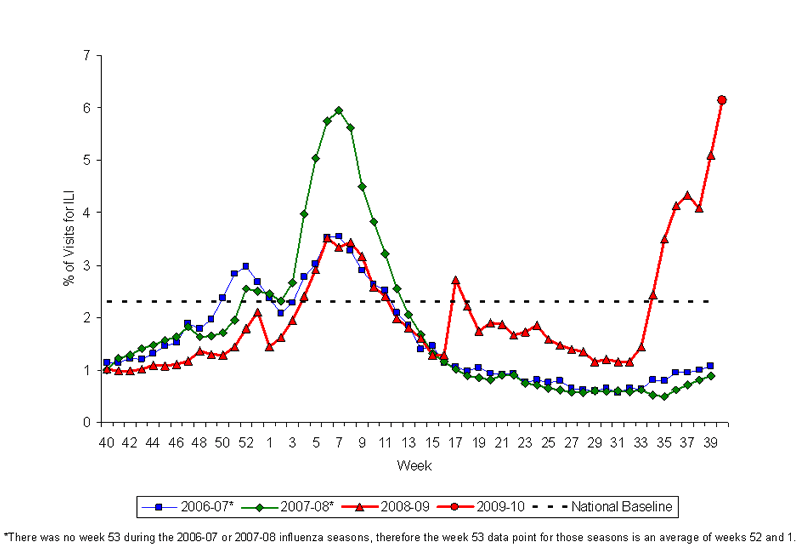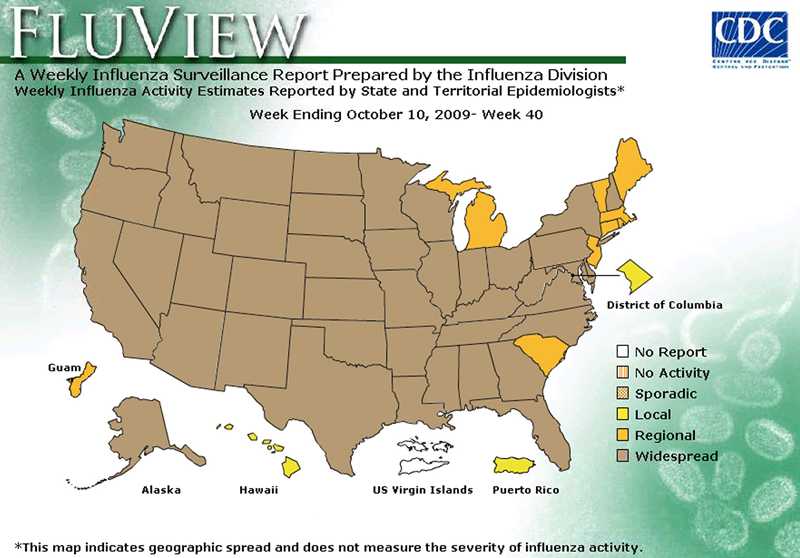Content on this page was developed during the 2009-2010 H1N1 pandemic and has not been updated.
- The H1N1 virus that caused that pandemic is now a regular human flu virus and continues to circulate seasonally worldwide.
- The English language content on this website is being archived for historic and reference purposes only.
- For current, updated information on seasonal flu, including information about H1N1, see the CDC Seasonal Flu website.
2009 H1N1 Flu U.S. Situation Update
October 16, 2009, 7:30 PM ET
Map: Weekly Influenza Activity Estimates Reported by State and Territorial Epidemiologists
(Activity levels indicate geographic spread of both seasonal and 2009 influenza A [H1N1] viruses)
(Posted October 16, 2009, 7:30 PM ET, for Week Ending October 10, 2009)
For information about how this map is updated, see Questions & Answers About CDC's Online Reporting.
Percentage of Visits for Influenza-like Illness (ILI) Reported by the U.S. Outpatient Influenza-like Illness Surveillance Network (ILINet), National Summary 2008-2009 and Previous Two Seasons
(Posted October 16, 2009, 7:30 PM ET, for Week Ending October 10, 2009)

Cases Defined by |
Hospitalizations |
Deaths |
|
|---|---|---|---|
| Influenza and Pneumonia Syndrome* | 15,696 | 2,029 | |
| Influenza Laboratory-Tests** | 4,958 | 292 | |
*Reports can be based on syndromic, admission or discharge data, or a combination of data elements that could include laboratory-confirmed and influenza-like illness hospitalizations. **Laboratory confirmation includes any positive influenza test (rapid influenza tests, RT-PCR, DFA, IFA, or culture), whether or not typing was done. This table is based on data reported to CDC by U.S. states and territories from a new influenza and pneumonia hospitalizations and deaths web-based reporting system. This system will be used to monitor trends in activity for the 2009-10 influenza season. This is a cumulative count beginning August 30, 2009. The table shows aggregate reports of all influenza and pneumonia-associated hospitalizations and deaths (including 2009 H1N1 and seasonal flu) since August 30, 2009 received by CDC from U.S. states and territories. This table will be updated weekly each Friday at 11 a.m. For the 2009-2010 influenza season, states are reporting based on new case definitions for hospitalizations and deaths effective August 30, 2009. CDC will continue to use its traditional surveillance systems to track the progress of the 2009-2010 influenza season. For more information about influenza surveillance, including reporting of influenza-associated hospitalizations and deaths, see Questions and Answers: Monitoring Influenza Activity, Including 2009 H1N1. The number of 2009 H1N1 hospitalizations and deaths reported to CDC from April – August 2009 is available on the Past Situation Updates page. For state level information, refer to state health departments. International Human Cases of 2009 H1N1 Flu Infection |
|||



